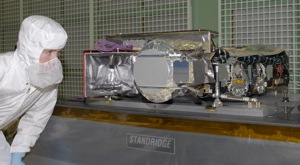 |  |  |  |  | Solar Dynamics Observatory Instrument to Peer Inside the Sun Arrives at Goddard
|
11.16.07
|
The Helioseismic and Magnetic Imager, an instrument for the Solar
Dynamics Observatory built by Stanford University and the Lockheed
Martin Solar Astrophysics Laboratory, Palo Alto, Calif., has arrived at
Goddard Space Flight Center, Greenbelt, Md. The imager will use a
technique called "helioseismology" to gaze through the Sun at internal
processes that will help us to understand the origins of solar weather.
It is one of three instruments on the
Observatory.
 Image right: The Helioseismic and
Magnetic Imager, an instrument for the Solar Dynamics Observatory,
built by Stanford University and the Lockheed Martin Solar Astrophysics
Laboratory, Palo Alto, Calif., has arrived at NASA's Goddard Space
Flight Center in Greenbelt, Md. Click image for enlargement. Credit: NASA
Image right: The Helioseismic and
Magnetic Imager, an instrument for the Solar Dynamics Observatory,
built by Stanford University and the Lockheed Martin Solar Astrophysics
Laboratory, Palo Alto, Calif., has arrived at NASA's Goddard Space
Flight Center in Greenbelt, Md. Click image for enlargement. Credit: NASA
Near the surface of the Sun, extremely hot, ionized gas is churned up
by convection, just like a pot of boiling water. These motions generate
the Sun's magnetic field, but also create sound waves that move through
the Sun. It is possible to see these sound waves as Doppler shifts when
they hit the surface of the Sun, each one hinting at the activity going
on below. Once launched aboard Solar Dynamics Observatory (SDO), the
Helioseismic and Magnetic Imager (HMI) will measure these Doppler
shifts over the entire visible part of the Sun. The data will then be
used to create maps of the Sun's interior and the plasma flows that
generate its magnetic field. To do so, HMI will measure 120 million
pieces of data every 45 seconds.
This is no small task, "It’s like deducing the interior structure of a
piano by listening to it fall down a flight of stairs," explained Phil
Scherrer, SDO HMI Principal Investigator. "In a sense we hope to
measure the sound of the sun in magnetically active regions, which
generate a lot of severe solar weather.”
The technique of tracing sound waves reverberating inside the sun to
build up a picture of the interior is known as "helioseismology" and
works similar to the way an ultrasound scan is used to create a picture
of an unborn baby. Helioseismology can even be used to map sunspots all
the way on the other side of the sun from Earth. The precursor to HMI
is the Michelson Doppler Imager (MDI), launched in 1995 on board the
Solar and Heliospheric Observatory. MDI however has only limited
coverage of the Sun, whereas HMI will provide a full-disk view with
about one thousand times the data. HMI will also be capable of
measuring the strength and direction of the magnetic fields emerging on
the Sun’s surface.
 Image left: SDO contains a suite
of instruments that will provide observations leading to a more
complete understanding of the solar dynamics that drive variability in
the Earth's environment. Click image for enlargement. Credit: Ryan Zuber/NASA GSFC
Image left: SDO contains a suite
of instruments that will provide observations leading to a more
complete understanding of the solar dynamics that drive variability in
the Earth's environment. Click image for enlargement. Credit: Ryan Zuber/NASA GSFC
SDO will carry two other instruments in addition to HMI. It is hoped
the combination of their observations will enable researchers to
establish the relationships between the internal dynamics and surface
activity. "These three instruments together will enable scientists to
better understand the causes of violent solar activity, and whether
it’s possible to make accurate and reliable forecasts of space
weather," said Liz Citrin, SDO Project Manager at NASA Goddard. "SDO
will provide a full disk picture of the sun in super HD quality."
The Extreme Ultraviolet Variability Experiment (EVE) arrived at Goddard
this September and the Atmospheric Imaging Assembly (AIA) will arrive
before the end of the year. SDO and its components will be integrated
and go through rigorous testing at Goddard’s state-of-the-art
facilities up until it is shipped for launch sometime between the end
of 2008 and the beginning of 2009.
SDO will be the first mission of NASA’s Living with a Star program. The
goal of both SDO and Living with a Star is to help us understand and
work towards predicting the changes in the Sun that influence life on
Earth and human technology.
SDO is being designed, managed, and assembled at NASA Goddard. HMI was
built in Palo Alto, Calif. at Stanford's partner institution Lockheed
Martin Solar Astrophysics Laboratory (LMSAL) as project of the Stanford
Lockheed Institute for Space Research. The Stanford group will provide
the science data processing center for both the HMI and the AIA
instruments. AIA is also being built at LMSAL. EVE was built by the
University of Colorado at Boulder.
Related Links:
+ Animations depicting how instruments like HMI (and its precursor, the Michelson Doppler Imager) peer inside the sun
+ More information about the Solar Dynamics Observatory
Andrew Freeberg
Goddard Space Flight Center
|
|  |

